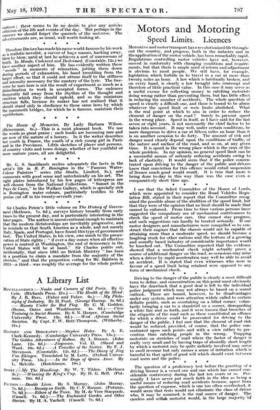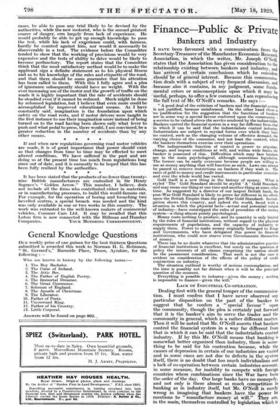Motors and Motoring
Speed Limits. Licences
MOTORING and motor transport have revolut ionized life through- out the country, and progress, both in the industry and in the application of the motor vehicle, has been remarkably rapid. Regulations controlling motor vehicles have not, however, moved inconformity with changing conditions and require- ments, but that there is ample need.of reform and adjustment is obvious to most people. We still have, for example. legislation which forbids us to travel in a car at more than twenty miles an hour. A law which is habitually broken, and on every hand, is dearly a law brought into contempt and therefore of little practical value. In this case it may serve as a useful excuse for collecting money in catching motorists doing wrong rather than preventing them, but has little effect in reducing the number of accidents. The whole question of speed is clearly a difficult one, and there is bound to be abuse whatever the speed limit or were limits abolished. What is the real point at which to aim in order to reduce the element of danger on the road ? Surely to prevent speed in the wrong place. Speed in itself, as I have said for the last seven or eight years, is not necessarily the chief factor to be taken into account. It may well, under certain conditions, be more' dangerous to drive a car at fifteen miles an hour than it is on another occasion to do forty. The amount of risk and danger must clearly depend upon the conditions of traffic, of the nature and surface of the road, and so on, at any given time. It is speed in the wrong place which is the crux of the whole problem. In my opinion, no general speed limit can be a successful means of seriously reducing accidents owing to lack of elasticity. It would seem that if the police concen- trated upon driving to the danger of the public and drivers knew that conviction for this offence would entail suspension of licence much good would result. It is true that more is being done to-day in this way than was the case even a comparatively short time ago.
I see that the Select Committee of the House of Lords, which were appointed to consider the Road Vehicles Regu- lation Bill, stated in their report that the Committee recog- nized the possible abuse Of the abolition of the speed limit, but that they were of the opinion that no limit should be made that cannot be enforced. From time to time various persons haw suggested the compulsory use of mechanical contrivances to check the speed of motor cars. One cannot stay progress, and such suggestions can hardly be treated seriously. If our motor designers and manufacturers were compelled so to con- struct their engines that the chassis would not be capable of attaining more than a moderate speed, we should become a laughing stock for other nations and the bottom of a growing and soundly based industry of considerable importance would be knocked out. The Committee reported that the evidence showed that a mechanical check might actually prove a source of additional danger on the road, as occasions may arise when a driver by rapid acceleration may well be able to avoid an accident. It is stated that even witnesses who were in favour of a speed limit being retained were opposed to any form of mechanical check.
Driving to the danger of the public is clearly a most difficult term to define, and concentration on this point must obviously have the drawback that a good deal is left to the individual police judgment which may not always be based on a sound outlook. There are bound, however, to be disadvantages under any system, and were attention widely called to certain definite points, such as overtaking on a blind corner, volun- tarily bringing a car to a standstill on a corner, disregarding a white line and so forth, and it were known that breaches of the etiquette of the road such as these constituted an offence for which a driver could be prosecuted for driving to the danger of the public, I feel sure that the element of road risk Would be reduced, provided, of course, that the police con- centrated upon such points and with a view rather to pre- vention than catching people in the wrong. Trapping motorists on stretches of road where the factor of danger is really very small and by having traps of absurdly short length by which a motorist may be quite unfairly involved may serve to swell revenue but only causes a sense of irritation which is harmful to that spirit of good will which should exist between road users and the police.
The question of a proficiency, test before the granting of a driving licence is a vexed one and one which has caused con- siderable controversy during the last ten years or so. Per- sonally I have never put much faith in the idea as being a useful means of reducing road accidents because, apart from the question of expense, which is one too often overlooked, it would seem that tests would not eliminate the class of driver who, it may be assumed, is the real source of danger. The careless and selfish motorist would, in the large majority )of cases, be able to pass any trial likely to be devised by the authorities, while the new motorist, who is the second greatest source of danger, errs largely from lack of experience. He would probably be able to get up enough knowledge to pass the test, while his lack of experience could, with fairness, hardly be counted against him, nor would it necessarily be discoverable in a test. The evidence before the Committee tended to show that the working of provisions would be very expensive and the tests of ability to drive would be likely to become perfunctory. The report states that the Committee think that the most satisfactory method would be to make the applicant sign a definite statement as to his physical fitness and as to his knowledge of the rules and etiquette of the road, and that there should be sonie guarantee that his attention has been' called to them. With this I fully agree and a plea of ignorance subsequently should have no weight. With the ever increasing use of the motor and the growth of traffic on the roads it is highly important that the rate of accidents should be steadied even if it cannot be reduced. Much might be done by reformed legislation, but I believe That even more could be accomplished by improved educational means. As I have constantly said, imagination is the foundation upon which safety on the road rests, and if motor drivers were taught in the first instance to use their imagination-nioreinstead of being turned on to the road having been shown only what lever to push and what pedal to press, there would-iI am convinced, be a greater reduction in the number of accidents than by any other means.
* * * If and when new regulations governing road motor vehicles are made, it is of great importance that power should exist so that changes from time to time may be effected to meet altered conditions. We have suffered in the past and are doing so at the present time too much from regulations long since out of date, and it is earnestly to be hoped that this has been fully realized by the authorities. * * * *
It has been stated that the products of no fewer than twenty- nine British manufacturers are embodied in Sir Henry Segmve's "Golden Arrow." This number, I- believe, does not include all the firms who contributed either in materials, or in manufacturing processes, to build this world-famous car. For example, for the operation of boring and broaching two bevelled centres, a special broach was needed and the kind was only available in one or two works in this country. The work was entrusted to the well-known makers of commercial vehicles, Commer Cars Ltd. It may be recalled that this Luton firm is now connected with the Hillman and Humber
Companies. YOUR MOTORING CORRESPONDENT.













































 Previous page
Previous page